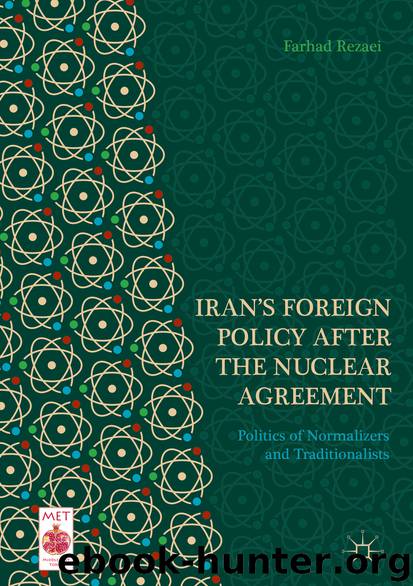Iran’s Foreign Policy After the Nuclear Agreement by Farhad Rezaei

Author:Farhad Rezaei
Language: eng
Format: epub
Publisher: Springer International Publishing, Cham
Toward a Shiite–Sunni–Kurdish Federation?
The fall of Mosul and the brutal rampage of al-Baghdadi’s forces added tension to the fraught relations between the moderate normalizers and the hardliners in Tehran. Having struggled with a complicated nuclear negotiation, President Rouhani felt that the high-profile exploits of Suleimani called unnecessary attention to the continuation of Iran’s revolutionary export. To minimize the danger to the pending nuclear agreement, the Joint Comprehensive Plan of Action (JCPOA) , Rouhani wanted Suleimani replaced with Ali Shamkhani, advisor to the Supreme Leader and the secretary of the SNSC.
If the moderates acted logically in seizing upon the ISIS debacle to settle accounts with the QF, the criticism of Suleimani within the IRGC came as a surprise. As one observer noted, “ISIS was a stain on Suleimani who ignored them because he concentrated on defending Assad.” Mashreq News, an outlet affiliated to the Revolutionary Guards, agreed with the moderates, writing that that Ali Shamkhani, secretary of the Supreme National Security Council of Iran (SNSC), and SNSC should make decisions regarding Iraq . In a remarkable piece of editorializing, Mashreq stated that “many do not pay much attention to the fact that the main mission of the Quds Force is fighting against Israel . Suleimani was put in charge of Iraq’s political portfolio only because of the need to coordinate between the Iraq and the Syrian front operations.” According to Mashreq, in the new division of labor, “Shamkhani will be in charge of Iraq and Suleimani will fulfill the decisions which will be made by SNSC.”38
Suleimani, however , was not ready to give up his role as a “kingmaker” in Iraq politics. To the contrary, he insisted on supporting his long-term ally al-Maliki who was losing ground over his stringent anti-Sunni policies. With Sunni protests gaining strength, Rouhani concluded that al-Maliki needed to go. Ayatollah Khamenei apparently shared this view as well as Grand Ayatollah Sistani, the spiritual leader of the Iraq Shiites . The latter sent a message to al-Malaki urging him to resign, but Suleimani , who still pushed for a Lebanon version of Iraq , demurred. In Tehran, the moderate media amplified its attacks on Suleimani , blaming his brutal anti-Sunni campaign for the growth of ISIS. Backed by the Supreme Leader , Rouhani deputized Shamkhani to step in and engaged in the complex maneuvers to replace al-Maliki with the Heider al-Abadi, a moderate Shiite politician.”39
Al-Abadi curtailed much of the abuse of the Sunnis and made his government more inclusive, a policy which President Rouhani supported. But Suleimani did not abandon the political-military arena. By utilizing his extensive contacts, the QF chief created the formidable Popular Mobilization Forces (PMF) or Hashid Shaabi, a conglomerate of several groups— Muqtada al-Sadr’s Mahdi Army , Asa’ib Ahl al-Haq, Liwa’a Zulfiqar, Kata’ib Sayyid al-Shuhada, Kata’ib Hezbollah , Liwa’a ‘Ammar Ibn Yasir and Munadhamat Badr. Saraya Khorasani, formed by the call of Ayatollah Khamenei, achieved a special prominence among the PMF. Its Iranian leader, Brigadier General Hamid Taghavi Abu Mariam who died in the fighting, was declared a war hero and featured on billboards together with Khamenei.
Download
This site does not store any files on its server. We only index and link to content provided by other sites. Please contact the content providers to delete copyright contents if any and email us, we'll remove relevant links or contents immediately.
| Automotive | Engineering |
| Transportation |
Whiskies Galore by Ian Buxton(41544)
Introduction to Aircraft Design (Cambridge Aerospace Series) by John P. Fielding(32897)
Small Unmanned Fixed-wing Aircraft Design by Andrew J. Keane Andras Sobester James P. Scanlan & András Sóbester & James P. Scanlan(32583)
Craft Beer for the Homebrewer by Michael Agnew(17940)
Turbulence by E. J. Noyes(7720)
The Complete Stick Figure Physics Tutorials by Allen Sarah(7154)
Kaplan MCAT General Chemistry Review by Kaplan(6606)
The Thirst by Nesbo Jo(6458)
Bad Blood by John Carreyrou(6286)
Modelling of Convective Heat and Mass Transfer in Rotating Flows by Igor V. Shevchuk(6232)
Learning SQL by Alan Beaulieu(6048)
Weapons of Math Destruction by Cathy O'Neil(5855)
Man-made Catastrophes and Risk Information Concealment by Dmitry Chernov & Didier Sornette(5676)
Digital Minimalism by Cal Newport;(5404)
Life 3.0: Being Human in the Age of Artificial Intelligence by Tegmark Max(5201)
iGen by Jean M. Twenge(5175)
Secrets of Antigravity Propulsion: Tesla, UFOs, and Classified Aerospace Technology by Ph.D. Paul A. Laviolette(5024)
Design of Trajectory Optimization Approach for Space Maneuver Vehicle Skip Entry Problems by Runqi Chai & Al Savvaris & Antonios Tsourdos & Senchun Chai(4851)
Electronic Devices & Circuits by Jacob Millman & Christos C. Halkias(4760)
